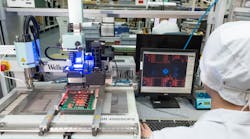After meeting with a bipartisan group of senators February 24, President Biden signed an executive order aimed at improving domestic supply chains for critical domestic goods, including semiconductors. The order, which directs members of the Cabinet to engage in 100-day reviews of the relevant products’ supply chains, comes after automakers and members of Congress signaled growing alarm at critical shortages of semiconductor chips used in passenger vehicle manufacturing.
President Biden, in remarks given at the signing, also urged Congress to fund $37 billion in short term funding to increase domestic semiconductor manufacturing specifically.
Other supply chains the order will investigate are those for large-capacity batteries for electric vehicles, cars themselves, pharmaceuticals, and rare earth metals.
The order directs members of the President’s cabinet to investigate areas where the U.S. is not producing critical goods in to six areas: communications technology, defense, energy, food production, public health, and transportation. The sectoral review is modeled after a similar process used by the Department of Defense to regularly evaluate the U.S. defense industrial base.
“Resilient American supply chains will revitalize and rebuild domestic manufacturing capacity, maintain America’s competitive edge in research and development, and create well-paying jobs,” the order reads.
“We need to make sure these supply chains are secure and reliable,” said Biden in remarks to the press. Shortages of PPE earlier in the pandemic, Biden said, “should never have happened. We shouldn’t have to rely on a foreign country—especially one that doesn’t share our interests or our values—in order to protect and provide our people during a national emergency.”
Bob Bruggeworth, CEO of the Semiconductor Association, praised the move and urged the president and Congress to “invest ambitiously” in domestic semiconductor production. “Doing so will ensure more of the chips our country needs are produced on U.S. shores, while also promoting sustained U.S. leadership in the technology at the heart of America’s economy strength and job creation, national security, and critical infrastructure,” said Bruggeworth.




